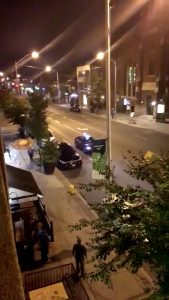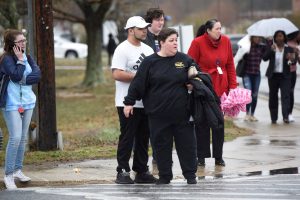
By Anna Mehler Paperny
FREDERICTON, New Brunswick (Reuters) – Four people, including two police officers, were killed in a shooting in eastern Canada on Friday in the latest eruption of gun violence across the country that has led to calls for weapons bans in cities.
Police said a suspect was taken into custody just three weeks after a gunman walked down a busy Toronto street, killing two people and wounding 13 others before taking his own life.
Police in Fredericton, a city of about 56,000 that is the capital of the province of New Brunswick, said two of the dead were police officers but gave few details about the circumstances of the shooting and did not release names. They said the suspect was being treated for serious injuries.
Local media images showed emergency vehicles converging on a tree-lined residential street. Nearby facilities were closed and authorities imposed a lockdown for residents before issuing an all-clear message.
“It was scary,” said Marlene Weaver, who was in bed on Friday morning when she heard shots ring out in her neighborhood. “It takes you back to the shooting in Moncton.”
Three RCMP officers were killed and two more were wounded in 2014 in Moncton, New Brunswick, about 195 km (121 miles) from Fredericton, in one of the worst incidents of its kind in Canada.
Gun laws in Canada are stricter than in the United States but a proliferation of weapons has led to an increase in gun-related crimes in recent years.
Canadian Public Safety Minister Ralph Goodale said the Royal Canadian Mounted Police (RCMP) were assisting Fredericton authorities in the investigation.
New Brunswick had only three homicide shootings in 2016, according to Statistics Canada.
“Awful news coming out of Fredericton,” Canadian Prime Minister Justin Trudeau said on Twitter. “My heart goes out to everyone affected by this morning’s shooting. We’re following the situation closely.”
Jeff Magnussen, general manager of a golf course near the site of the shooting, said by phone he heard multiple gunshots before 8 a.m. local time.
“You hear a lot about gun violence in the United States,” he said, “but this morning when I heard those noises, what’s starting to sink in is that those noises were people losing their lives. To have it happen so close to us is shocking. Now we’re becoming the story that nobody wants to hear.”
In the wake of the Toronto bloodshed, the city council voted overwhelmingly to urge the federal government to ban the sale of handguns in the city. Gun laws are under federal jurisdiction.
“Why does anyone in this city need to have a gun at all?” Toronto Mayor John Tory said. Canada’s largest city has had 241 shooting incidents this year, resulting in 30 deaths, a 30 percent increase in fatalities.
On Thursday, Ontario pledged more money for police and to keep suspects behind bars while they await trial on gun crimes charges, as the Canadian province grapples with rising shootings involving domestically obtained weapons.
(Additional reporting by Danya Hajjaji and Allison Martell in Toronto and David Ljunggren in Ottawa; Writing by Bill Trott; Editing by Steve Orlofsky and Jeffrey Benkoe)










